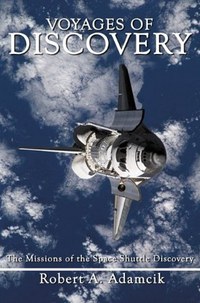Review: Voyages of Discoveryby Jeff Foust
|
| The crew of STS-51C, an early Defense Department mission, went to great pains to not publicize a trip to an NRO facility to California, only, upon arriving at their motel, to see a sign reading, “Welcome STS-51C Astronauts”. |
Voyages of Discovery is, at its core, a chronological review of the 38 missions Discovery has flown since it entered service in 1984 (STS-133, scheduled for launch Thursday, will be the 39th.) This includes a wide range of missions, from satellite repair missions and the launch of spacecraft to visits to the Russian space station Mir and the assembly of the International Space Station. Discovery was involved with some milestone missions over its history, from the return to flight after both the Challenger and Columbia accidents to the launch of the Hubble Space Telescope to John Glenn’s return to space on STS-95 in 1998. Each of these missions is recounted in summaries in the book running several pages each.
While these summaries of the missions are straightforward, they can be relatively dry. Often they are simply day-by-day recitations of what took place during each mission, with a minimum of editorializing, analysis, or other insights beyond what you would find in mission summaries prepared by NASA. (Adamcik does sprinkle a few anecdotes into the book, such as describing how the crew of STS-51C, an early Defense Department mission, went to great pains to not publicize a trip to an NRO facility to California, only, upon arriving at their motel, to see a sign reading, “Welcome STS-51C Astronauts”.) The book does contain over 300 images of the mission—none in color, unfortunately, other than the cover—but some are so small it’s hard to see any detail. For example, one image of the rollout of Discovery after its construction includes a caption identifying the crew of its maiden flight on stage, but the image is so small it’s all but impossible to pick out those astronauts in the photo.
There is a subtle bit of editorializing about the shuttle in Voyages of Discovery, in how Adamcik names the sections of the book. The section about the early history of Discovery, up until the Challenger accident, is titled “The Golden Age”. The post-Challenger era, up until the Columbia accident, is “The Silver Age”, while the post-Columbia era devolves to “The Bronze Age”. It suggests things are not as good as they once were, or at least were promised to be. As the shuttle—an incredibly complex, capable vehicle that still fell short of the promises of a revolution in space transportation upon which it was sold, nearly 40 years ago—fades into history, this wistfulness for an earlier, more promising era is a theme likely to be repeated.
